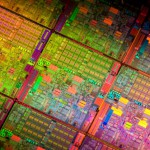
The process is due to enter production in H2 2022.
Compared to 5nm, the 3nm process, has a 10-15% speed improvement at the same power or a power reduction of 25-30% at the same speed, with a logic density improvement of 1.7x, an SRAM density improvement of 1.2x and an analogue density improvement of 1.1x.
It is thought that the iPad will be first to get 3nm chips with the next generation of iPhone using the 4nm half-node.
Intel is said to be initially using the 3nm node for notebook PC processors and datacentre CPUs.
Another early adopter of the 3nm process is expected to be Graphcore of Bristol which is reported to be using the process to make a processor containing over 100 billion transistors.
Intel has delayed its 7nm process until 2023 but, according to Scotten Jones of IC Knowledge: “Intel’s 7nm process is projected to have a TSMC equivalent node of 4.3nm. Intel’s 7nm process falls between TSMC’s 5nm and 3nm process in density.”
“If Intel can get back to a two-year node cadence with 2x density improvements around mid-decade they can be roughly at density parity with TSMC,” says Jones,
Intel CEO Pat Gelsinger has said he is mandating a one-year cadence for node migrations.
As for performance, Jones reckons: “My expectation is that Intel’s 7nm process will be competitive with TSMC’s 3nm process on a performance basis.”
AMD is reported to be planning to adopt TSMC’s 5nm chip process for its notebook processors next year.
Nvidia’s first server CPU chip, due in 2023, will use TSMC’s 5nm process.